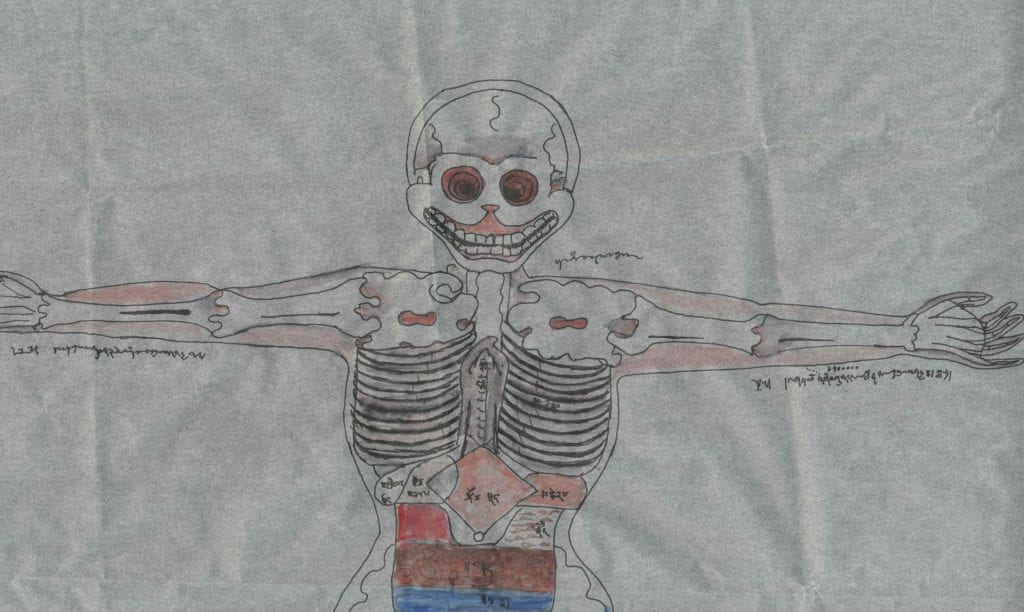Katherine Wu //
“It looks swollen,” said Dr. Liang. He looked at my tongue. “Do you have vivid dreams?”
I didn’t think much about my tongue until then—But it’s a body part that’s both inside and outside of the body. The tongue can tell us about many things [pause for sound effects]. We use the tongue to taste—and tasting flavor can profoundly impact our internal lives. In Chinese Medicine, each of the 5 flavor groups: acrid, sweet, sour, salty, and bitter, treats different disorders.1 And overindulgence in these flavors can transmute diseases to have other symptoms, for example, bitter flavors can give rise to vomiting.2 But the tongue can do more than just taste, it also has medical uses.
Tongue diagnosis reveals the state of the Three Humors: blood, phlegm, and bile,3 and connects to a cosmology of signs that allows a skilled practitioner to read symptoms. It’s a comprehensive view of a person’s health, often characterized by color and texture, but even connected to the mind, such as the presence of vivid dreams.
[music]
Organs too have multiple functions and colors that can impress upon the body like soft wax.4 In Tibetan medicine, the organs are separated into the five solid viscera—heart, lungs, liver, spleen, kidneys—and six hollow viscera—stomach, small intestine, large intestine, gallbladder, urinary bladder, and reservoir for reproductive fluid.5 Unlike Galen’s Four Elements in Greek and Islamic Medicine, or quasi-Daoist Four Agents in East Asian classical texts, Tibetan Medicine considers an imbalance in any organ to be caused first by an imbalance in digestion.6 This is no ordinary upset stomach, but something more. Like Chinese Medicine, this abstraction renders the body into a “black box” — unknowable, unseeable, and uninviting to the imagination.7
The organs are important, not just for digestion, but even for storing emotion [music]. It’s all about balance, and balance has to do with weight. In your yearly check-up appointment, they will always measure your weight. If your digestional tract works properly, then your inputs, such as calories, and outputs should be roughly the same each day to maintain a consistent body. Good health is preserved when the elimination of waste is steady and unimpeded. According to the early modern Venetian physiologist Santorio, Santorio: “Bad qualities arise…when the body is not one day the same weight as another,” because an increase in weight signals an “accumlation of putrefying wastes” and “retention of crudities.”8 But inputs are not exactly equal in weight to outputs. In fact, sweat was thought of as a type of “unseen excerment”. In 1769, English theologian John Wesley claimed that “obstructed perspiration is one of the great sources of diseases.”9
So what does the tongue tell us? If it has teeth markers, there’s too much water. If it’s cracked, too much phlegm. Our organs are always at work, balancing, expressing, like a black box. And in my body, they continue to express themselves, even in my sleep and for as long as I wish.
NOTES
- Husihui. et al., A Soup for the Qan: Chinese Dietary Medicine of the Mongol Era as Seen in Hu Sihui’s Yinshan Zhengyao : Introduction, Translation, Commentary, and Chinese Text, 2nd ed. (Leiden: Brill, 2010), [Page 378].
- Ibid.
- Subhuti Dharmananda, “Tibetan Herbal Medicine,” last modified May 2001, accessed October 24, 2019, http://www.itmonline.org/arts/tibherbs.htm.
- Park, Katharine, 1950-. Secrets of women: gender, generation, and the origins of human dissection. New York : Zone Books, 2010. http://hdl.handle.net/2027/heb.09090.0001.001.
- Juri Parfionovic, Gyurme Dorje, and Fernand Meyer, Tibetan Medical Paintings: Illustrations to the “Blue Beryl” Treatise of Sangye Gyamtso (1653-1705) : Text (New York: Abrams, 1992), [Page 185, 187].
- Paolo Roberti di Sarsina, Luigi Ottaviani, and Joey Mella, “Tibetan Medicine: A Unique Heritage of Person-centered Medicine,” The EPMA Journal, 2011, accessed October 24, 2019, https://www.ncbi.nlm.nih.gov/pmc/articles/PMC3405412/.
- Judith Farquhar, “Eating Chinese Medicine,” Cultural Anthropology 9, no. 4 (1994): [Page 475], http://www.jstor.org/stable/656385.
- Shigehisa Kuriyama, “The Forgotten Fear of Excrement,” Journal of Medieval and Early Modern Studies, October 1, 2008, [Page 416], accessed October 20, 2019, https://doi.org/10.1215/10829636-2008-002.
- Ibid, 417.
Bibliography
Dharmananda, Subhuti. “Tibetan Herbal Medicine.” Last modified May 2001. Accessed October 24, 2019. http://www.itmonline.org/arts/tibherbs.htm.
Husihui., Paul D. Buell, Eugene Newton Anderson, and Charles Perry. A Soup for the Qan: Chinese Dietary Medicine of the Mongol Era as Seen in Hu Sihui’s Yinshan Zhengyao : Introduction, Translation, Commentary, and Chinese Text. 2nd ed. Leiden: Brill, 2010.
Kuriyama, Shigehisa. “The Forgotten Fear of Excrement.” Journal of Medieval and Early Modern Studies, October 1, 2008. Accessed October 20, 2019. https://doi.org/10.1215/10829636-2008-002.
Park, Katharine, Secrets of women: gender, generation, and the origins of human dissection. New York : Zone Books, 2010. http://hdl.handle.net/2027/heb.09090.0001.001.
Parfionovic, Juri, Gyurme Dorje, and Fernand Meyer. Tibetan Medical Paintings: Illustrations to the “Blue Beryl” Treatise of Sangye Gyamtso (1653-1705) : Text. New York: Abrams, 1992.
Roberti di Sarsina, Paolo, Luigi Ottaviani, and Joey Mella. “Tibetan Medicine: A Unique Heritage of Person-centered Medicine.” The EPMA Journal, 2011, 385-89. Accessed October 24, 2019. https://www.ncbi.nlm.nih.gov/pmc/articles/PMC3405412/.


